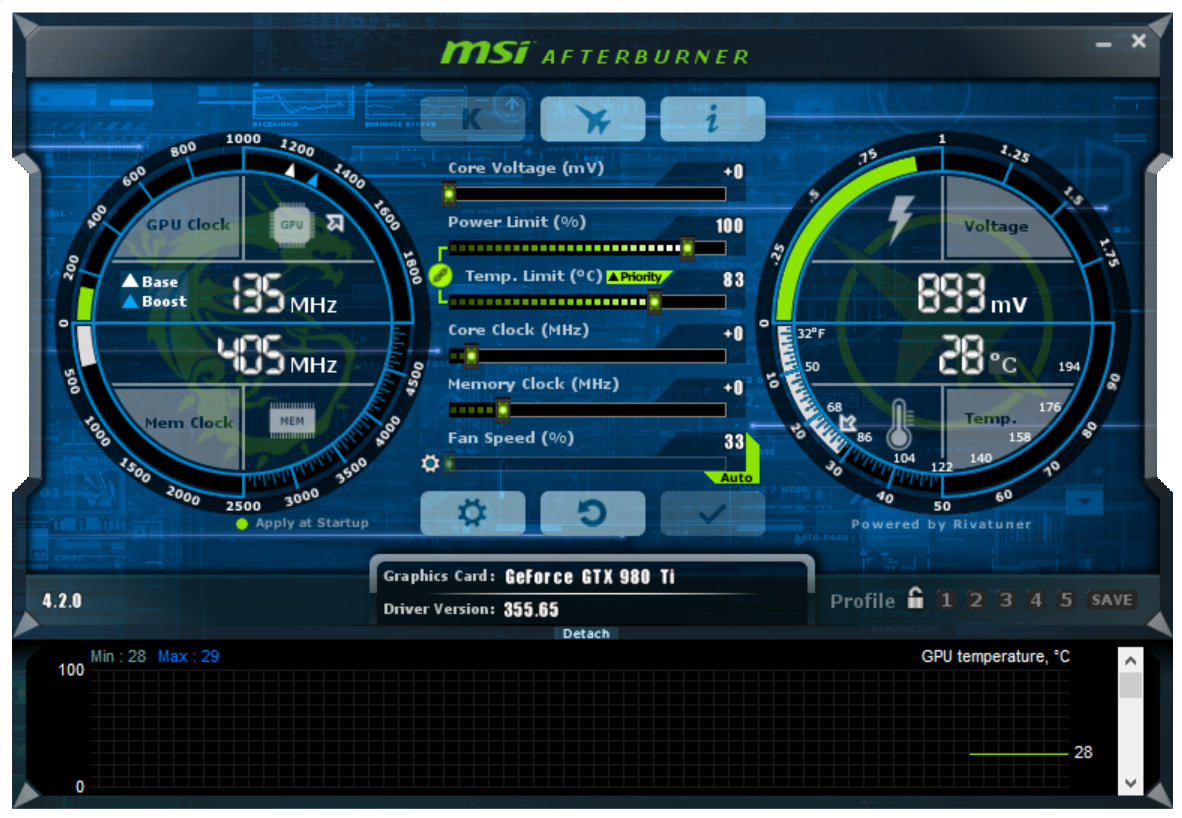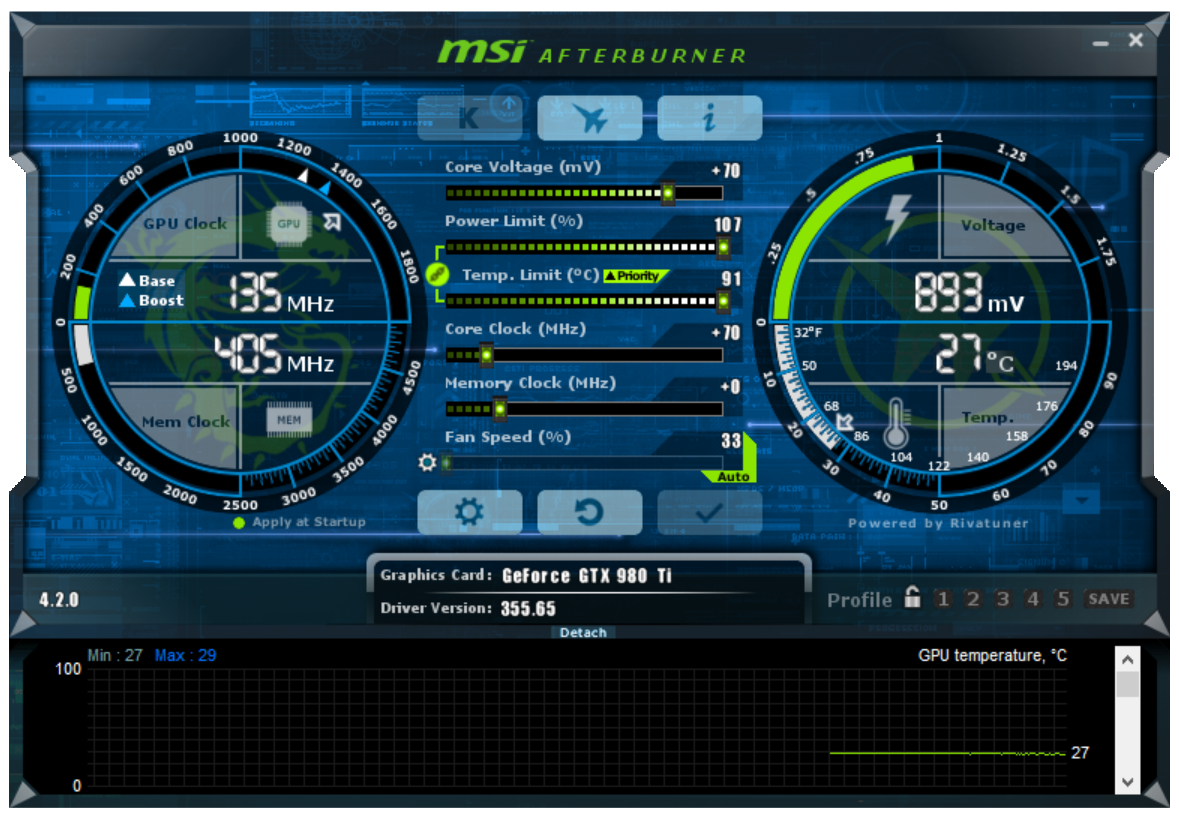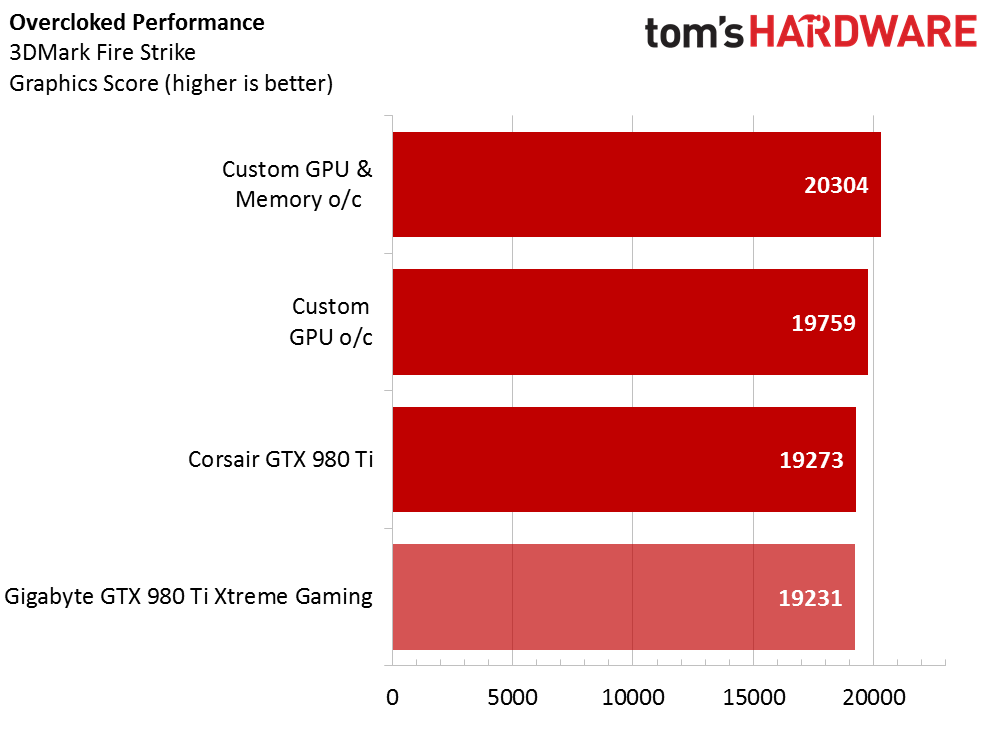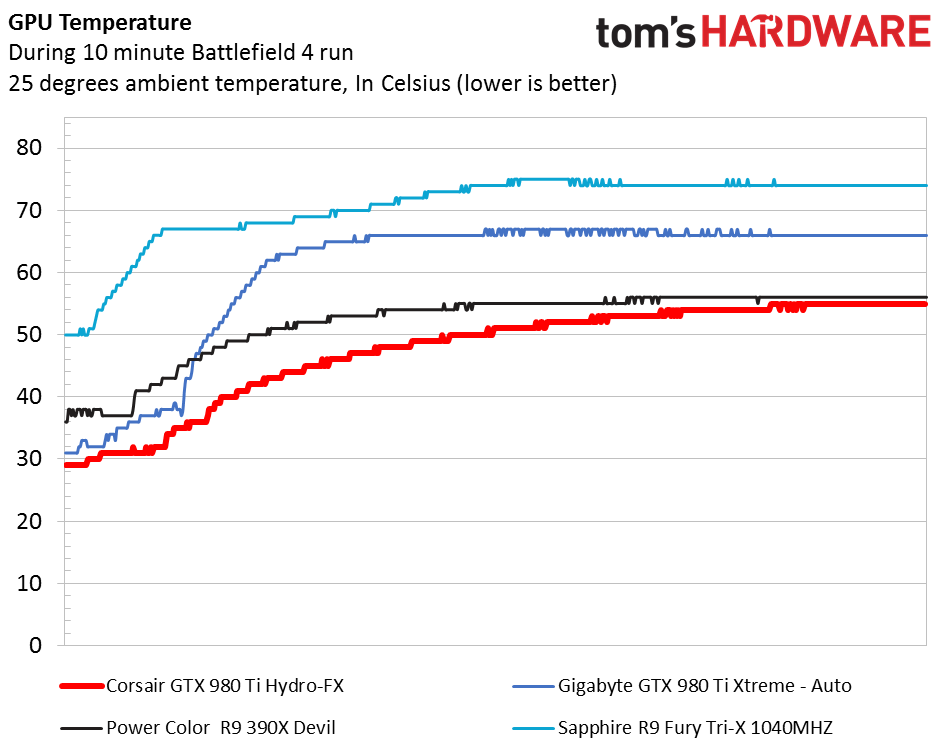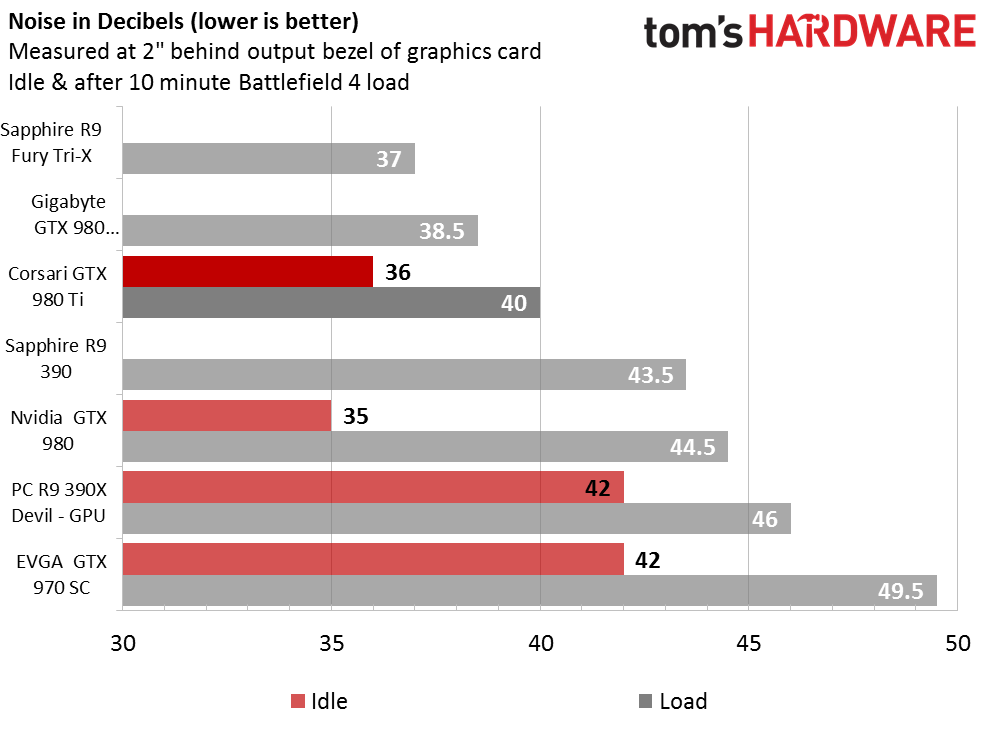Corsair Hydro GFX GeForce GTX 980 Ti Review
Corsair doesn't like tackling a new market unless it can offer a premium product. So when the company wanted to make a graphics card, it partnered with MSI to create a high-end stunner.
Why you can trust Tom's Hardware
Overclocking, Temperature, Noise And Power
Overclocking
Before adjusting any settings, we ran 3DMark at the Hydro GFX's stock clock rates to get a baseline score. Right off the bat, Corsair's card scored 16,638 on 3DMark with a graphics score of 19,791. Those numbers seemed high, so we re-ran the test with GPU-Z logging the board's vital signs. Upon reviewing the log, we found that the Hydro GFX was hitting GPU Boost clocks as high as 1429.4MHz out of the box.
Next, we turned the temperature and power limits to their maximum allowed levels. The 91 °C thermal ceiling never came into play; Corsair's H55 cooler kept the GM200 under 60 °C. The more forgiving power limit is what we were really after. Our 3DMark numbers rose again, demonstrating no ill effects from our changes.
We started by tweaking the GPU clock rate. Given the high GPU Boost frequency previously observed, we jumped in 25MHz increments. Once we hit a base clock rate of 1265MHz, our increases shrank to 5MHz. After dialing in each new setting, we ran 3DMark Fire Strike to test stability.
Over time, we determined that a 1370MHz base (80MHz higher than stock) was as far as we could go without a voltage increase. Beyond that, 3DMark would crash mid-run.
With ample thermal headroom, we started to increase the voltage using MSI Afterburner, hoping to stabilize an even more aggressive overclock. As a test, we dropped the frequencies back to their stock levels and starting increasing voltage in 10mV steps, again running 3DMark after making each change. Higher than 70mV, performance started to drop, so we used that as our voltage offset and went back to work on the GPU clock rate. Ultimately, we managed to get a stable (or so we thought) 1278MHz base frequency with GPU Boost rated at 1379MHz. What we actually observed during our test run was a significantly higher 1518MHz, though.
With the GPU dialed in, we moved on to memory. Corsair stressed that the GDDR5 it uses should overclock to 8 GT/s without trouble, so we took the company up on the challenge. Starting with the GPU at its stock frequency, we gradually cranked the memory up to 8080 MT/s. That was a stable setting on its own. But with the GPU overclocked as well, Corsair's card wasn't stable (it locked up in our Battlefield 4 temperature test).
Ultimately, we found a compromise with the GPU set to 1260MHz, GPU Boost at 1361MHz and the memory at 7896 MT/s. The GPU Boost frequency we observed in practice was closer to 1500MHz, though.
Get Tom's Hardware's best news and in-depth reviews, straight to your inbox.
Temperature
Unsurprisingly, Corsair's Hydro GFX runs much cooler than its competition. We've seen liquid cooling used quite effectively several times before in the graphics world, and Corsair's H55 appears to be a good match for Nvidia's GM200 GPU.
The idle temperature we measured is slightly lower than Gigabyte's GeForce GTX 980 Ti Xtreme Gaming with its always-on fan profile. Further, Corsair's Hydro GFX is nearly 10 °C cooler than PowerColor's water-cooled Devil R9 390X.
Even after 10 minutes under load, the Hydro GFX remains several degrees cooler than PowerColor's card. In fact, at no time does the GPU reach the 60-degree threshold that triggers the fans on most air-cooled cards.
Noise
Because the Hydro GFX employs a hybrid cooler, there are several components that can generate noise: the axial fan on the radiator, the pump and the card's centrifugal fan. We measured acoustic output next to the radiator and from behind the graphics card, but our instrument didn't pick up a reading from the radiator so we didn't add that to the chart.
From behind the card, even at idle, the decibel meter registered 36 dB(A). We attribute this to the always-on blower-style fan. But after 10 minutes of gaming, the board remained relatively quiet. Gigabyte's GeForce GTX 980 Ti Xtreme Gaming is slightly less noisy, but Corsair's temperature advantage justifies its slight deficit in our acoustic measurements. And at least the Hydro GFX is a lot quieter than PowerColor's liquid-cooled R9 390X Devil.
Power
In a recent GTX 980 Ti review, we were surprised by higher-than-expected power consumption. Not long after, our colleague from Germany, Igor Wallossek discovered that Nvidia drivers released after version 355.65 have a bug with X99 systems that cause higher power consumption. With an older driver package installed, the Hydro GFX lands right around 18.1 watts.
Corsair's card may behave itself at idle, but it gets power-hungry in 3D workloads. Our measurements suggest that, in stock form, the card draws 267W in Battlefield 4. Overclocked, that number jumps to 276W. Sapphire's R9 Fury Tri-X OC ducks in at 258W in the same metric.
Curiously, the Hydro GFX uses less power than Gigabyte's GeForce GTX 980 Ti Xtreme Gaming in FurMark. In stock form, Gigabyte's card draws 19W more than Corsair's board after it was overclocked.
Current page: Overclocking, Temperature, Noise And Power
Prev Page Gaming Benchmarks Next Page ConclusionKevin Carbotte is a contributing writer for Tom's Hardware who primarily covers VR and AR hardware. He has been writing for us for more than four years.
-
envy14tpe These liquid cooled GPUs are cool, but why are they so fugly? I have yet to see one where the cables and style look good for the price. I'd rather slap a custom loop on a non liquid cooled GPU.Reply -
toddybody These hybrid coolers are just plain ugly.Reply
Why can't nVidia/board partners design a conventional block/pump as with the FuryX?
For the money, I'd rather buy a KINGPIN 980ti or CLASSIFIED...and would probably reach a higher OC because of it's improved PCB and power delivery. -
clonazepam Kevin Carbotte, thank you so much for the article.Reply
I'm really curious about this cooler. It's funny, I was just thinking about these Corsair coolers and what it might do for my reference Titan X. I've obviously hit the exact same clocks and performance level as the card in the article, prior to the voltage increase. I hit the power limit wall of 1370Mhz boost, with +390 on the memory, and being reference, less than 10 degrees to spare.
What I'm curious about is the additional performance gained from the voltage increase and hitting that boost of 1500Mhz. The gain from a Firestrike score of like 19500 to 20300 or something doesn't seem like much. The nerd in me though would probably justify the upgrade price just as an excuse to tinker with the card and all that.
How much do you think you gained from a power limited overclock to going all out? -
junkeymonkey I thought them seahawk cards were pulled due to the Asetek lawsuits ??Reply
that card been long gone
https://pcpartpicker.com/part/msi-video-card-gtx980tiseahawk
any updates on that would be nice to update me ....
toms OLD review of this card from 2015
http://www.tomshardware.com/news/msi-corsair-gtx-980ti-announced,30104.html -
clonazepam Reply17675998 said:I thought them seahawk cards were pulled due to the Asetek lawsuits ??
that card been long gone
https://pcpartpicker.com/part/msi-video-card-gtx980tiseahawk
any updates on that would be nice to update me ....
Its sold as a Corsair graphics card, directly from Corsair's own store. -
sillynilly I'm so confused - you say: "But because it doesn't appear commercially available, we can't consider it much more than an exhibition."Reply
However, it is listed for sale on Corsair's site for direct sale at $699.99. -
JackNaylorPE I really don't see the "surprise" here with the card being made by MSI .... someone else makes most of Corsair's products. It's disappointing to see a cooler review without a discussion of radiator material, presence of mixed metals nor fan rpm.Reply
In addition, the comparison between an overclocked Corsair / MSI card that manages beats down the Gigabyte G1 "outta the box" is not exactly "apples and apples". Head to head, both overclocked or both "outta the box", the G1 (and numerous other cards) take the performance crown and they do so while running quieter.
"Ultimately, we found a compromise with the GPU set to 1260MHz, GPU Boost at 1361MHz"
Gigabtye G1 1310 / 1399
http://tpucdn.com/reviews/Gigabyte/GTX_980_Ti_G1_Gaming/images/gpuz_oc.gif
MSI Gaming 1280 / 1381
http://tpucdn.com/reviews/MSI/GTX_980_Ti_Gaming/images/gpuz_oc.gif
"Gigabyte's GeForce GTX 980 Ti Xtreme Gaming is slightly less noisy, but Corsair's temperature advantage **justifies** its slight deficit in our acoustic measurements."
Justifies ? In what way ? The user is impacted in a real and measurable way by the additional noise. In what way does the user benefit, other than bragging rights at 50C ? Let's keep in mind that many 9xx series fans turn off their fans below 65C because manufacturers so need to have the noise below this temperature and the air cooled, overclocked G1 tops out at just 71C OC'd at load. A 2,000 pound rated hoist will get the same job done lifting a 1,000 pound load as a 5,000 pound rated hoist.
http://tpucdn.com/reviews/Gigabyte/GTX_980_Ti_G1_Gaming/images/temp.gif
If the OC will be limited in any way by temperatures, it's going to be via the conventionally cooled VRM rather than the 50C GPU. While 50C is a testament to the cooler design, as a "whole card", the hybrids bring nothing to the table for the additional $110, No performance throttling will occur until the card hits the 85Cthrottling point. It should also be noted that the G1 idles at 27C almost half as loud as the Hybrid.
I'm not against water cooling. I'm against consumers being duped into buying an C:LC type cooler for implied gains that are never materialized. I make these comments typing from a box with two watercooled cards (EK Blocks), 5 x 140m of rad in push / pull, and dual DDC pumps, I did it because I wanted a dead silent system, not because I expected better performance out of the video cards. The cards GPU runs about 44C under Furmark while fans remain inaudible... at 1200 rpm, I can hit 39C but as there is nothing to be gained from going so, I'll take the silence. The cards are overclocked 26% which is the max stable OC I was able to obtain with these particular cards. Best we have done on air with this card series was 28%. -
hardarse7 The GTX 1080 is *RIGHT* around the corner (April/May), with 2x performance per watt over the current cards. And the 1080Ti is going to have HBM2, probably in June. Why would anyone buy a GPU now with Pascal about to drop?Reply -
JackNaylorPE I think those expectations are extremely optimistic. While we expect the announcement in May / June ... we will 1st see the reference cards some time after that and then the non-refernce ones we actually want to buy some time again after that. The 980 Ti was released 9 months after the 980 ... I'd expect no faster delivery of the next Ti.Reply
